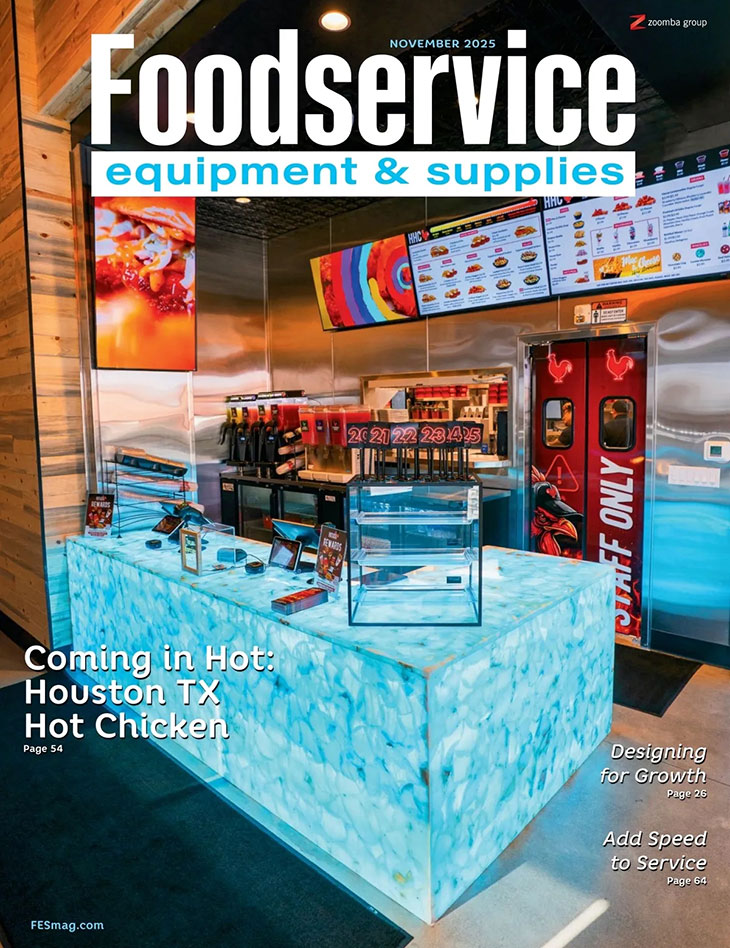A new prototype moves this renowned barbecue operation into the fast-casual space.
It’s normal for a chain restaurant to evolve, but not many attempt a change like the one Famous Dave’s seeks to pull off.
Famous Dave’s was founded more than 30 years ago in Hayward, Wis., by “the” Dave, Dave Anderson. A barbecue guru, Anderson was the chain’s original pitmaster, serving everything from smoked brisket to ribs to pulled pork to barbecue chicken. The concept thrived, and Anderson expanded Famous Dave’s into dozens of states before selling to MTY Food Group in 2022.
 The new dining area uses wood tones and reds with white accents. The vinyl mural is the central piece of the design.Today, most Famous Dave’s locations are full-service, casual-dining restaurants. Footprints vary, but most measure around 6,000 square feet with seating for more than 200 — which can make it difficult to find good real estate. They also cost around $1.5 million to build. That’s a price that many aspiring franchisees simply can’t (or won’t) meet.
The new dining area uses wood tones and reds with white accents. The vinyl mural is the central piece of the design.Today, most Famous Dave’s locations are full-service, casual-dining restaurants. Footprints vary, but most measure around 6,000 square feet with seating for more than 200 — which can make it difficult to find good real estate. They also cost around $1.5 million to build. That’s a price that many aspiring franchisees simply can’t (or won’t) meet.
Faced with these challenges, Famous Dave’s leadership concluded it was time to develop an alternative. “There’s not a ton of appetite right now for people building 6,000-square-foot restaurants,” says Al Hank, co-chief operations officer of BBQ Holdings, the chain’s holding company, and a longtime Famous Dave’s executive.
The company began thinking about a change around 2018, Hank adds. At that point, Famous Dave’s off-premises sales were about 40% of revenue. That number has only grown since. “When you look at the consumer behavior shifting so much off-premises, you don’t need that large of a dining room,” says Hank. “This conceptually became the idea of needing a smaller box, shrinking the dining room and being able to emphasize some other things.”
Over the past several years, Famous Dave’s has tested several versions of a smaller box, such as models with a drive-thru and a restaurant where guests walk down a line and pick out their meat and sides from wells.
Now, the company believes it has landed on the right design: a fast-casual-style operation measuring less than 2,000 square feet with around 15 to 20 seats. The price tag? Just $500,000. The first of these locations opened in March in Brookfield, Wis., just outside of Milwaukee.
“This allows us to position ourselves to attract new franchisees,” Hank says. “We’ve been successful in creating a much more economical prototype with quicker cash-on-cash returns, which can lead to faster expansion. It opens us up to a completely new segment and demographic of potential franchisees.”
 The chain’s new high-humidity ovens, used to heat cooked proteins, are electric and do not sit under a hood.
The chain’s new high-humidity ovens, used to heat cooked proteins, are electric and do not sit under a hood.
2025 BBQ Look
Obviously, switching from a full-service model to fast casual means Famous Dave’s dining area changed as well. That’s more a function of the size, though, Hank says. “This look and feel isn’t necessarily new to this prototype,” he explains. “This has been part of our refresh package that some of our restaurants have gone through over the last two years. If you look at how we’re designing these restaurants versus the historical Dave’s, I’d say we’re modernizing Dave’s a little bit and bringing it into what a barbecue restaurant looks like in 2025 versus what it did in 1990. It’s a little bit brighter with a lot of white accents.”
The new prototype still looks like a barbecue restaurant, though. Its primary color is red — the most classic of barbecue colors — along with various shades of wood tones and, of course, those white accents. You can see many of these colors in the furnishings. The red metal chairs, for instance, pair with laminate tables that boast a light wood tone. Guests can also choose darker wood banquette seating. The restaurant’s flooring also touches on the wood theme, this time in wood-inspired tile.
While reds and woods are nods to barbecue culture, other design elements shout it out even louder. Phrases on the walls in red and blue include “Swining & Dining,” for example. A black and white vinyl mural features illustrations of animals and their different cuts of meat, along with more barbecue-centric sayings like, “In Meat We Trust” and “Get Sauced.”
This mural, Hank notes, is also customized to the local market. “We still believe in that heritage or home type of callout in the store — and tying it into some local connection, some local roots,” he says.
Another key piece of the design is the pass-through window from the back of the house to the point-of-sale area. This extra-large opening gives guests the chance to see Famous Dave’s team members hard at work, chopping and plating barbecue and cooking burgers and fries.
 Famous Dave’s new kitchen features a hot line with fryers, a chargrill and a flattop. The assembly area connects to the front of the house through a large pass-through window.
Famous Dave’s new kitchen features a hot line with fryers, a chargrill and a flattop. The assembly area connects to the front of the house through a large pass-through window.
BBQ, but Without the Smoker
Not surprisingly, guests at the new Famous Dave’s won’t see much in the kitchen, at least compared with full-service locations. And while Famous Dave’s is able to execute a broad menu in this space — offerings include proteins, salads, wings, chicken strips, burgers, pies and numerous sides — guests don’t have quite as many choices as they do in a full-service location.
The core proteins all remain, but other offerings have been dropped. In some cases, the goal was to remove items that were basically redundant. The new prototype still sells burgers, for instance, but only two or three types versus seven or eight on the full-service menu. Other items that are a better fit for full service, like cedar plank salmon, have been removed entirely.
The items that remain are produced in a kitchen that’s gotten a complete makeover.
The biggest change: no more smokers — at least, not in the restaurants themselves. Instead, the chain now has their meat purveyors smoke nearly all proteins to the company’s specifications and then ship them to Famous Dave’s locations. In the restaurants, staff heat the proteins using three special high-humidity ovens, typically during overnight hours.
According to Jeff Shapiro, culinary director for BBQ Holdings, there’s no loss in quality with this approach. In fact, the chain may look at using it in Famous Dave’s full-service restaurants. “We found that by doing overnight rethermalization, the meat becomes very tender, holds its moisture level, holds its bark and holds its smoke rings,” he says.
What’s more, by heating with humidity, this equipment allows food to maintain its quality longer. Plus, says Famous Dave’s Director of Operations Chuck Cummings, the equipment can cook low and slow, which is key to successful barbecue.
“Think about that from an execution standpoint,” Cummings says. “If you know you have a certain amount of catering in the morning, you can preload that the night before, walk in the next morning, and literally just start filling pans and executing your tickets for the day.”
 The exterior of the new fast-casual-style Famous Dave’s.
The exterior of the new fast-casual-style Famous Dave’s.
These high-humidity ovens are on one end of the hot line. They’re electric, so they sit outside the hood. While they play a key role in making entrees, they are also used for tasks like making trays of bacon and baking cornbread muffins. The other end of the hot line starts with the fry station, which includes fryers as well as a refrigeration unit to hold items like chicken tenders and french fries.
Next to this station is a range top, where kitchen staffers heat up sides like beans and corn, followed by a small flattop grill used to toast buns for sandwiches and heat up burnt ends. Previously, notes Shapiro, Famous Dave’s used a toaster for buns, which was naturally limited in what it could do. Switching to a flattop allowed the chain to execute more functions on a single unit.
After the flattop comes a chargrill for cooking burgers. Team members also use this piece for ribs: They take a cooked and heated rack, sauce it, then caramelize it right on the grill. “That’s what really brings out all the sugar on the ribs. It takes us about five full minutes, and the grill has to reach 500 degrees to execute that procedure,” Cummings says.
Notably, different proteins are held in different places before hitting the chargrill. Raw beef for burgers, along with toppings like cheese, are stored in refrigerated drawers beneath the grill. Ribs and rib tips, both already cooked, are kept in the high-humidity ovens, which are set to a safe holding temperature.
Opposite the hot line sits the assembly line. Starting opposite the fryers, this setup opens with a salad table. Below the table are warming drawers that use the same technology as the high-humidity ovens. These drawers hold proteins, including brisket and ribs.
The setup allows staffers at the steam wells, immediately to the left of the salad table, to quickly restock proteins. Past that unit is holding for cold sides like coleslaw, along with plenty of workspace to slice and chop different types of barbecued meat.
This new design is still in its early days, but Famous Dave’s has already learned lessons that can be applied to future stores. The biggest takeaway, says Hank, is the strength of the catering business. Barbecue travels well, so the company was expecting solid catering sales, but the Brookfield restaurant had a half-dozen catering orders in the first week — and that revenue stream has only grown since. New restaurants may get a fourth high-humidity oven to keep up with catering demand.
One of the obvious benefits of this new prototype is that it allows Famous Dave’s to move into new types of real estate with smaller footprints. This could open new types of markets for the concept, such as city centers, Hank notes.
The core of the business, though, will likely remain the same: middle- to upper-middle-class suburbs, often close to anchors like Wal-Mart and Home Depot.
At a Glance
- Chain headquarters: Minnetonka, Minn.
- Year founded: 1994
- Key players: Al Hank and Adam Lehr, co-chief operating officers
- Signature menu items: St. Louis-style ribs, Texas beef brisket,
Georgia chopped pork, country-roasted chicken, cornbread muffins and bread pudding - Number of units: 107
- Seats per unit (new prototype): 15-20
- Average unit volume: $2.65 million (reflects the chain’s existing portfolio of primarily full-service restaurants)



